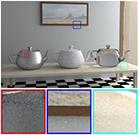Fusing State Spaces for Markov Chain Monte Carlo Rendering

Rendering algorithms using Markov chain Monte Carlo (MCMC) currently build upon two different state spaces. One of them is the path space, where the algorithms operate on the vertices of actual transport paths. The other state space is the primary sample space, where the algorithms operate on sequences of numbers used for generating transport paths. While the two state spaces are related by the sampling procedure of transport paths, all existing MCMC rendering algorithms are designed to work within only one of the state spaces. We propose a first framework which provides a comprehensive connection between the path space and the primary sample space. Using this framework, we can use mutation strategies designed for one space with mutation strategies in the respective other space. As a practical example, we take a combination of manifold exploration and multiplexed Metropolis light transport using our framework. Our results show that the simultaneous use of the two state spaces improves the robustness of MCMC rendering. By combining efficient local exploration in the path space with global jumps in primary sample space, our method achieves more uniform convergence as compared to using only one space.
Publication Date
Published in
Research Area
Copyright
Copyright by the Association for Computing Machinery, Inc. Permission to make digital or hard copies of part or all of this work for personal or classroom use is granted without fee provided that copies are not made or distributed for profit or commercial advantage and that copies bear this notice and the full citation on the first page. Copyrights for components of this work owned by others than ACM must be honored. Abstracting with credit is permitted. To copy otherwise, to republish, to post on servers, or to redistribute to lists, requires prior specific permission and/or a fee. Request permissions from Publications Dept, ACM Inc., fax +1 (212) 869-0481, or permissions@acm.org. The definitive version of this paper can be found at ACM's Digital Library http://www.acm.org/dl/.
